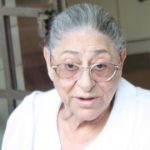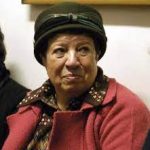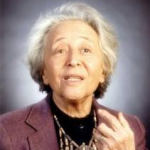Under the Radar
Where we talk to and learn about Mitzvah heroes, those amazing people who are doing their part in Tikkun Olam and making the world a better place to live in.

UNDER THE RADAR – 3 Women’s Legacies
Written by Arnie Draiman
This is a special column – Three short vignettes, dedicated to the memory of these special women.
HADASSAH LEVI
 A baby is born – joy and celebration? Not this time. The parents, upon seeing that their child has Down Syndrome, decide to abandon their child and leave the hospital without their newborn. Fortunately for this child, Hadassah Levi was sick, and in the hospital at the same time. Whenever Hadassah was in the hospital, she always headed to the maternity ward. “It cheers me up,” she said. She noticed that one child there was not being given as much attention as the others. She asked the staff, and they told her that his parents abandoned him in the hospital. Hadassah said she would take him, adopt him and raise him. Almost as an aside, the head nurse said, “We see about 30 of these a year.” Hadassah said, “If I recover, I will take them all.” And she did. In 1973, Hadassah created Maon Latinok – A House for Babies, with 38 Down Syndrome babies.
A baby is born – joy and celebration? Not this time. The parents, upon seeing that their child has Down Syndrome, decide to abandon their child and leave the hospital without their newborn. Fortunately for this child, Hadassah Levi was sick, and in the hospital at the same time. Whenever Hadassah was in the hospital, she always headed to the maternity ward. “It cheers me up,” she said. She noticed that one child there was not being given as much attention as the others. She asked the staff, and they told her that his parents abandoned him in the hospital. Hadassah said she would take him, adopt him and raise him. Almost as an aside, the head nurse said, “We see about 30 of these a year.” Hadassah said, “If I recover, I will take them all.” And she did. In 1973, Hadassah created Maon Latinok – A House for Babies, with 38 Down Syndrome babies.
Most people would say that raising one child, whether typically performing or one with special needs is a handful. But 38 with Down Syndrome? It takes a Hadassah Levy to do it. Without any training – medical or otherwise – she developed a strict dietary regimen which actually reduced some of the external features often associated with Down Syndrome children. After all the naysayers tried to shut her down, have the kids put in an institution, or ruled against giving her government funding, she slowly became recognized as a respected expert in her field.
Those children have all grown up now, and if you hang out in Jerusalem, you can see them working in restaurants, at the Knesset, and many other places.
Hadassah passed away in 2020. She was the sister of Yekutiel Adam, one of Israel’s most celebrated war heroes – the highest ranking officer ever killed in battle (Lebanon, 1982). Hadassah herself had been part of the Underground pre-State, having worked in David Ben Gurion’s office as an aide. But it’s her rescuing of those 38 children and the legacy she left behind that makes her a true Mitzvah hero.
RABBANIT BRACHA KAPACH
 A young girl learned by example from her mother about helping others, and often helping them anonymously – bringing them food late at night and hiding a sack of money mixed in with the food. This impression never left Bracha Kapach, who created a world filled with doing good. She started and ran for 40 years: a summer camp for kids at risk, a wedding dress gemach for brides who couldn’t afford to buy one, a weekly food distribution program (and on Passover, she would give out over 6000 packages of food!), a weekly Torah class for older women, a used clothing storeroom of not-so-used clothing, a weekly swimming class for single mothers, annual around-the-world trips for elders, and more.
A young girl learned by example from her mother about helping others, and often helping them anonymously – bringing them food late at night and hiding a sack of money mixed in with the food. This impression never left Bracha Kapach, who created a world filled with doing good. She started and ran for 40 years: a summer camp for kids at risk, a wedding dress gemach for brides who couldn’t afford to buy one, a weekly food distribution program (and on Passover, she would give out over 6000 packages of food!), a weekly Torah class for older women, a used clothing storeroom of not-so-used clothing, a weekly swimming class for single mothers, annual around-the-world trips for elders, and more.
Born in Yemen, and married at 11 to a cousin (15) who was trying to avoid being drafted, she and her husband made Aliyah in 1949 with four children, although one died on the journey from Yemen (by donkey and then boat) to Israel. Rav Yosef and Rabbanit Bracha Kapach were both awarded the Israel Prize (Israel’s highest prize), each for their own work. His was for his work with Maimonides’ original manuscripts, and hers for her all-encompassing Tzedakah work. While Rav Kapach was studying, he also worked as a jeweler and in the rabbinic court system, eventually attaining the position of chief justice. The Rabbanit learned to read and write along with her children, and she, too, became a highly educated, brilliant scholar. As if that wasn’t enough, she opened a factory for Yemenite embroidery with 40 employees. And one year, she was even asked to sew the IDF’s flag. She took no money for that, and when asked what they could do for her, she said she wanted to bring some friends to the recently captured Golan Heights. And so it was arranged that the Rabbanit and her friends (three buses full!) were among the first civilians allowed in. She could be seen in her kitchen at 3am Fridays, baking and cooking enough food to distribute before Shabbat.
Rabbanit Bracha Kapach passed away in 2013, and many of her programs continue to this day.
MYRIAM MENDILOW
 Who hasn’t seen a beggar on the streets of Jerusalem? Maybe we give a coin or two, or just say a nice word, or even ignore them. Myriam Mendilow had a different idea. “Let’s get them off the street, and doing something productive,” she said. She had been a teacher for many years, the kind of teacher everyone should have. One who encourages you, one who is intense, filled with fire and drive, and simply won’t let you go until you understand the material. In this case, the “material” was life, and how to treat elders.
Who hasn’t seen a beggar on the streets of Jerusalem? Maybe we give a coin or two, or just say a nice word, or even ignore them. Myriam Mendilow had a different idea. “Let’s get them off the street, and doing something productive,” she said. She had been a teacher for many years, the kind of teacher everyone should have. One who encourages you, one who is intense, filled with fire and drive, and simply won’t let you go until you understand the material. In this case, the “material” was life, and how to treat elders.
Myriam went to the Ministry of Labor in 1962 and asked them to give her someone who could teach bookbinding to the elders. Her idea was that the elders of Jerusalem would repair the schoolbooks for the children of Jerusalem. And that the children would come to see who was repairing their books, and then the kids would realize that elders can be productive and do good things in the world. She was told she was crazy.
But Myriam was a fighter, and didn’t take no for an answer – she got her bookbinding teacher. And then she went to the streets rounding up the beggars and convincing them to come to work. Not an easy task, as many beggars earn very good money on the streets, and she was only paying a token wage. But their dignity was important to her. This was in the time before the 1967 war when the city of Jerusalem was divided, with many empty buildings available. She was given a place (a former funeral home) in the Musrara neighborhood, near the Old City and City Hall, in what was then the border with Jordan.
Starting with nothing, Myriam grew the project into a series of workshops including weaving, metal works, carpentry, dentistry, ceramics, a bakery, and more. The project was called “Lifeline for the Elders” and still runs today. Myriam passed away in 1989, having restored self-respect to thousands of Jerusalem’s older citizens.
May Hadassah, the Rabbanit, and Myriam be remembered for a blessing. True giants they were (though not one of them was taller than 5’5”). We continue today to do good in the world, carrying on and learning from the great acts of kindness these Mitzvah heroes have accomplished.
Related Articles
Related
Under the Radar: Meredith Rothbart
Under the Radar Where we talk to and learn about Mitzvah heroes, those amazing people who are doing their part in Tikkun Olam and making the world a better place to live in.A feminist, an Orthodox hair-covered-with-a-head-scarf Zionist, an IDF veteran, a mother of...
Under the Radar: Joelle Eckstein
Under the Radar Where we talk to and learn about Mitzvah heroes, those amazing people who are doing their part in Tikkun Olam and making the world a better place to live in.Some of our Mitzvah heroes see a need not being taken care of and dive in to help. Others go...
Under the Radar: Phyllis and Tamar Heimowitz – Girlfriends of Fallen IDF Soldiers
Under the Radar Where we talk to and learn about Mitzvah heroes, those amazing people who are doing their part in Tikkun Olam and making the world a better place to live in. and guest author Eliana Klibanoff A young woman is crying, sobbing uncontrollably...
